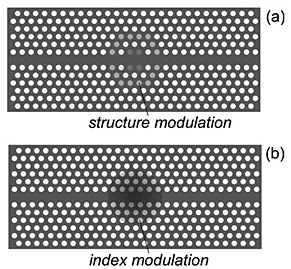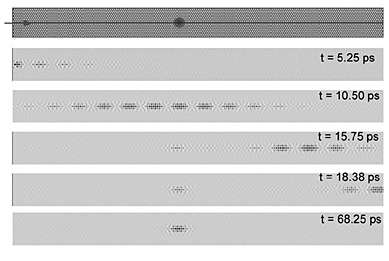Optical Science Laboratory
Recently, ultrahigh-Q nanocavities have been realized by small local structural modulation of
(typically, several nm shift of the air hole position) line-defect waveguides
in two-dimensional photonic crystals [1] [Fig. 1(a)]. This confinement
mechanism has been applied to various systems. Periodic structural modulation
has realized large-scale ultrahigh-Q coupled nanocavities [2], and ultrahigh-Q nanocavity modes have been also found in one-dimensional systems for the
first time by the structural modulation scheme [3].
Here we report that we have found similar ultrahigh-Q cavity modes can be formed only by refractive-index modulation of line-defect
waveguides without any structure modulation [4]. The most amazing feature
of this finding is that extremely small index modulation can realize ultra-strong
light confinement. For example, a Q value higher than 107 is possible with index modulation as small as Δn/n =4×10-4. In the case of Δn/n =3×10-3, the calculated Q reaches a surprisingly high value of 5 billions.
Such small index modulation can be achieved by various ultrafast optical nonlinearity. Thus, it may become possible to dynamically form an ultrahigh-Q cavity by local optical pumping. If so, we can pin (in other words, freeze)
a part of an optical pulse traveling in a line-defect waveguide by shining
a focused light pulse from the top surface. Figure 2 shows a numerical
simulation of this process, which indeed shows that the light intensity
inside the tuned area marked by a circle is pinned in a dynamically-formed cavity mode [4]. Detailed analysis has showed
that this process is driven by adiabatic wavelength conversion recently
experimentally observed in our group [5].
These results indicate that we can freely control ultrastrong light confinement
by very small modulation, which may open up novel functionalities in future
optical devices.
[1] T. Tanabe et al., Nature Photon. 1 (2007) 49.
[2] M. Notomi, E. Kuramochi et al., Nature Photon. 2 (2008) 741.
[3] M. Notomi et al., Opt. Express 16 (2008) 11095.
[4] M. Notomi and H. Taniyama, Opt. Express 16 (2008) 18657.
[5] T. Tanabe et al., Phys. Rev Lett. 102 (2009) 043907.
 |
 |
|||||
|
|